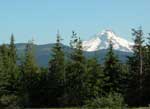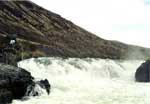 | | Mount Hood. |
"Reserved rights"
is an essential and continuing principle of tribal sovereignty. As acknowledged and specified in the Treaty with the Tribes of Middle Oregon 1855, the Warm Springs and Wasco tribes continue to have "reserved rights" over "ceded lands" and “usual and accustomed sites” off the reservation. In addition, the Confederated Tribes of Warm Springs owns land off the reservation and has the ability to request that those lands be placed under federal trust status. However, many of the off-reservation owned lands remain in a non-trust status, which requires the Confederated Tribes of Warm Springs to pay taxes on the land(s). While the Confederated Tribes of Warm Springs history with the United States has seen repeated attempts at threatening and undermining the sovereignty of the Warm Springs, Wasco and Paiute peoples, one of the most critical ways the Confederated Tribes of Warm Springs is today reasserting its role and responsibilities as an independent nation is through the exercise of their “reserved rights.” Working in close coordination with federal and state agencies, the responsibilities of the Confederated Tribes of Warm Springs includes restoration and preservation of all natural and cultural resources in these areas. The Branch of Natural Resources is charged with taking the lead in these responsibilities.
|
|
Robert "Bobby" Brunoe, General Manager for the Branch of Natural Resources, discusses the nature of "reserved rights" over “ceded lands” and “usual and accustomed sites,” as well as the off-reservation lands owned by the tribes, the responsibilities his programs and the tribe have to these areas. (Interviewed by Rodney Frey, July 2003) |
The ceded lands include the aboriginal territory once occupied by the Tribes of Middle Oregon who relinquished the land, but not their rights to the land, to the United States under treaty negotiations. In exchange for the ceded lands, the U.S. government is obligated to provide certain compensation and services. The ceded territory of the Warm Springs and Wasco tribes is over 10 million acres in size. It includes the area south from the Columbia River, with the Cascade Locks and the crest of the Cascade Mountains marking the western boundary, the 44th parallel marking the southern boundary, and the crest of the Blue Mountains and Willow Creek marking the eastern boundary. The Ceded lands thus encompassed all of the John Day River drainage and most of the Deschutes River drainage. During the treaty negotiations, the tribes reserved the right to continue to hunt, fish, gather traditional foods and pasture livestock on ceded, unclaimed lands. In addition, the Confederated Tribes of Warm Springs through its Branch of Natural Resources maintains fishery offices and facilities on the John Day and Hood rivers, and owns a fish hatchery on the Hood River just out of Parkdale, Oregon.
Also during the treaty negotiations, the tribes reserved the right to continue to access and use sites for traditional practices, as “usual and accustomed sites.” The usual and accustomed sites are areas located within and outside of the ceded lands where the tribes have traditional fisheries or other activities. A few of these sites are at Willamette Falls, the north shore of the Columbia River within what is known today as the Bonneville and The Dalles reservoirs, and the Sherar's Falls area, which lies within the ceded lands. At all of these places tribal members have the right to fish and practice their traditional activities.
 | | Sherar's Falls. |
The Treaty of 1855 identified the boundaries of the Warm Springs Reservation and its ceded lands. However, the Confederated Tribes of Warm Springs has the ability to expand its land base through purchase and acquisitions. When lands are acquired through their sale or other arrangement, the Confederated Tribes of Warm Springs has the right to request that those lands be put into trust by the US government's Department of Interior and become part of the current reservation land base.
Sherar's Falls, located within the ceded lands on the Deschutes River, is a traditional fishing site used by the Confederated Tribes of Warm Springs since time immemorial. Purchased by the Confederated Tribes of Warm Springs in the 1970s, the falls and lands adjacent to them have been put into trust. Currently, the Bureau of Land Management maintains the lands for the Tribe, however, tribal members continue to build their scaffols and fish for salmon at the falls. The Confederated Tribes of Warm Springs charges a use fee for non-tribal members to park at Sherar's Fall.
To continue listening to the interviews on these issues, go to Usual and Accustomed Supplement.
© Confederated Tribes of Warm Springs 2003
< previous | next >
|



